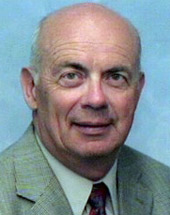Irv Lindemuth Jr., PhD

Irvin Lindemuth, PhD, retired in November 2003 after more than 32 years with the University of California, first at the Lawrence Livermore National Laboratory and then at the Los Alamos National Laboratory. At Los Alamos at the time of his retirement, Dr. Lindemuth was a special assistant for Russian collaboration in the Office of the Associate Director for Weapons Physics, the team leader for Magnetohydrodynamics and Pulsed Power in the Plasma Physics Group, and a project leader for Pulsed Power Science, Technology, and International Collaboration in the High Energy Density Hydrodynamics Program. His primary responsibility was to provide technical leadership for a scientific collaboration between Los Alamos and Los Alamos’s Russian counterpart, the All-Russian Scientific Research Institute of Experimental Physics (VNIIEF) at Sarov (Arzamas-16). Prior to joining Los Alamos in 1978, he was a technical staff member in A-Division at the Lawrence Livermore National Laboratory where he was involved in fusion research.
Dr. Lindemuth received his BS in electrical engineering in 1965 from Lehigh University, where he was a Hertz Scholar, and his MS and PhD in applied science engineering in 1967 and 1971, respectively, from the University of California, Davis/Livermore, where he was a Hertz Fellow. His thesis research was conducted under the advisorship of Dr. John Killeen, founder of the National Magnetic Fusion Energy Computer Center. One of his graduate school advisors was Edward Teller.
He has been an adjunct professor at the University of New Mexico Los Alamos branch, where he has taught engineering and mathematics courses. He spent the 1991-92 academic year as a visiting professor in the Nuclear Engineering Department of Texas A&M University, where he taught undergraduate and graduate courses, helped lay the groundwork for the department’s expansion into the controlled fusion area, and assisted the department in forming collaborations with Russian laboratories and educational institutions.
Although he has never participated in the U.S. inertial confinement fusion or magnetic confinement fusion programs, his areas of expertise include thermonuclear fusion and advanced numerical methods for the computer simulation of fusion plasmas and related pulsed power technology. He has published numerous papers in refereed journals and proceedings of major international conferences. He has been involved in a wide range of fusion and high energy density physics programs spanning essentially all of the ten orders of magnitude in density and time space from magnetic fusion energy plasmas to inertial confinement fusion plasmas. An internationally recognized pioneer in the application of implicit, non-split computational methods to magnetohydrodynamics, he has achieved widespread recognition for his large-scale numerical simulations of a variety of fusion and other high-density plasma systems. In addition to his accomplishments in modeling high temperature plasmas, he has formulated a variety of novel pulsed power computer codes that have led to important advances in laboratory programs. His codes have stimulated the development of several types of fast opening switches.
He is a U.S. pioneer in Magnetized Target Fusion (MTF) and performed the first comprehensive survey of the parameter space in which MTF was likely to work. Even before the collapse of the Soviet Union, he recognized that the Soviets had developed advanced technology in the areas of ultrahigh magnetic fields and ultrahigh energy electrical pulse generation that significantly exceeded U.S. capabilities and that were motivated by the Soviet MTF program known as MAGO. In January 1992, he became the first American scientist to present a formal scientific seminar at one of the formerly secret, and still closed, Russian nuclear weapons design laboratories. Dr. Lindemuth played an essential role in establishing the collaboration with VNIIEF, a collaboration that has helped integrate Russian weapons scientists into the global scientific community and that has resulted in more than 300 conference papers and archival publications. The LANL/VNIIEF collaboration, and Dr. Lindemuth’s role in it, were featured in the Discovery Channel documentary, Stockpile, which first aired in 2001. In 1992, Dr. Lindemuth was the recipient of a Los Alamos Distinguished Performance Award for his work in the formative stages of the LANL/VNIIEF collaboration.
In 2004, he was named a fellow of the Institute of Electrical and Electronic Engineers (IEEE). Dr. Lindemuth currently resides in Tucson, Arizona and is a part-time research faculty member of the Physics Department at the University of Nevada, Reno.
Graduate Studies
Awards
2020, Distinguished Career Award, Fusion Power Associates
2004, Fellow, Institute of Electrical and Electronic Engineers